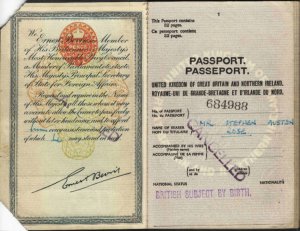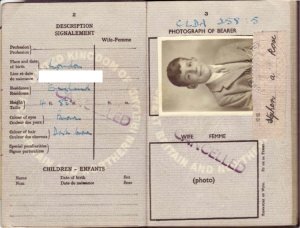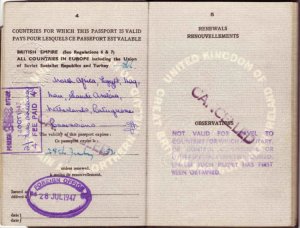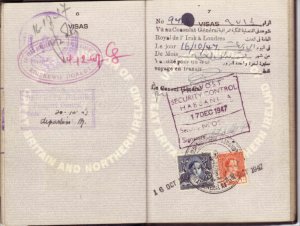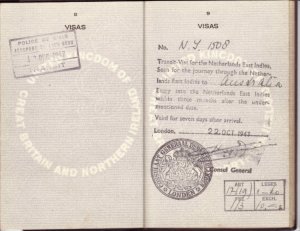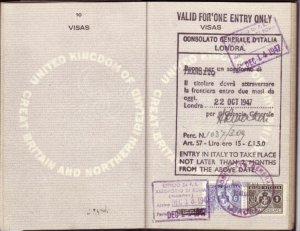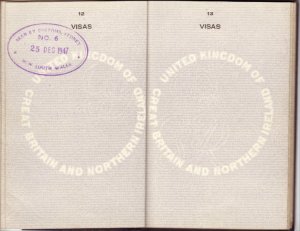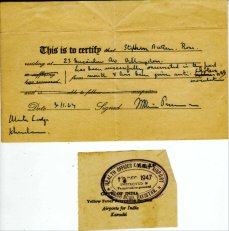The Remarkable Story of
Mr Rose and his Suitcase
| In
the immediate postwar years, there was a surplus of military
transport aeroplanes and a corresponding surplus of pilots,
many of whom wanted to put their training to peaceful (and
profitable) pursuits. Not surprisingly, they all wanted to
start their own airline. By 1947, migration to Australia was
booming and many budding entrepreneurs were drawn to this
lucrative trade with a motley collection of aircraft including
a DH.86 biplane, Lockheed Hudsons and Lodestars, Douglas DC-2s,
DC-3s and even a rare DC-5. One such operator was Sydney based
Intercontinental Air Tours which was founded in 1947 by one
Warren Henry Grindrod Penny, an experienced pre-war and RAAF
transport pilot. Included in their fleet was Lockheed Lodestar
G-AGBU which Penny purchased from British Overseas Airways
Corporation. It was the delivery flight of this aeroplane
which was to provide transportation to a new life in Australia
for a mother and her young child, nine year-old Stephen Rose
and this is his story. |
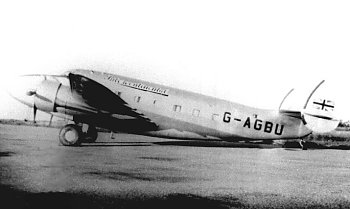
Lockheed Lodestar
G-AGBU
A Trip from the UK to Australia in 1947
by Stephen Rose
|
My mother was
widowed in 1943 when my father died from the results of
being gassed during WWI. Relatives, with good intentions,
were trying to tell her how I was to be educated and brought
up. My elder brother and sister had both served in the War
and wanted to have their own lives and raise families of
their own. My mother decided there was no future in staying
in the UK - the options were to migrate to Canada - too
cold; South Africa - trouble was already brewing there;
or Australia.
Unfortunately, in 1947 there was an 18 month waiting list
to get any sort of passage to Australia, whether by sea
or by air. About mid 1947 she saw an advertisement offering
air passage to Australia for £350 per person. Pilots being
demobbed were pooling their savings and acquiring aircraft
to fly to Australia to start airlines and this was one such
venture. All we had to do was pay up, get the necessary
vaccinations, and have all the necessary clothes and possessions
in a suitcase not exceeding a weight limit of 45 pounds.
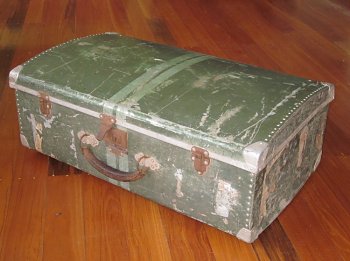
Stephen
Rose migrated with his Mother to Australia
with all their worldly possessions in this aluminium suitcase
which he has kindly donated to QAM.
The first departure was aborted when the plane was damaged
striking a hangar door. (The aircraft had been stored in
Africa pending sale and it was being ferried to the UK by
a BOAC crew for delivery to Intercontinental. Ed) So a few
weeks later we had to be at Heathrow for an early morning
departure on 12th December 1947*. The repairs to the aircraft
took longer than expected and we did not depart until about
14.00 - in fact we were in such a hurry that the plane did
not have the oxygen bottles for flying over the Alps - so
were limited to 16,000 feet. There were four crew, Capt
Penny, a co-pilot, a radio/engineer and an air hostess -
the wife or girl friend of one of the crew. There were 14
passengers including two children - myself, 9 years old
(going on for 10!) and Pat who was about 7. The rest were
thirtyish to middle aged, mostly couples. There were only
12 fixed seats and two extras that were not bolted down
- for us kids. (Not that it made much difference as I was
most of the time up in the cockpit with the crew or watching
the earth fly by through the drift sight which was installed
in the passenger cabin).
Due to our late start and lack of oxygen, we flew to Lyons
for the first night. This was my first experience of ersatz
coffee - served French style in cups like soup bowls! Next
stop was Rome (13/12*). The crew earned a little extra fuel
money that afternoon by flying refugees. The next day the
aircraft smelled of spring onions. In the UK we were still
on rations so many of the passengers ate too much of the
abundant food at the hotel and were very airsick the next
day.
The next leg was to Athens (14/12*) where the airport was
under armed guard due to the civil war. I think we may have
overnighted in huts at the aerodrome. The next day was to
Nicosia, Cyprus (15 &16/12*) where we stayed two nights
while the plane was used to ferry refugees. It was a very
noisy place as every motorist drove with a hand on the horn!
From here we flew to Habbaniya in Iraq (17/12*) - a mud-brick
fort out in the desert.
The next day we stayed at Bahrein (18/12). From here we
flew to Karachi and got sent to Delhi. Between the time
we left the UK and arrived there, self government had taken
effect and cholera had broken out and we would have had
to be quarantined hence being sent on to the other place.
Here we had to stay in the transit area overnight (19/12).
The next stop was Rangoon (20/12). All I remember is the
many canals we had to go over between the landing strip
and the hotel. Next day we were supposed to go to Singapore
but that was closed due to the wide-spread cholera epidemic,
so we stayed at Penang in Malaya (21/12). The next day we
refuelled at Batavia (now Jakarta) again an airport under
armed guard as the Dutch were fighting the the rebels. We
overnighted in Bali (22/12) where the airstrip was on a
plain surrounded by paddy fields. The hotel was colonial
Dutch and each bungalow was linked by a covered walkway.
We travelled from the strip to the hotel by military jeep.
That evening the adults visited a nearby temple.
Then came the long sea crossing to Darwin which is relatively
flat so not readily visible in the haze until you are almost
there. Here we landed at the old aerodrome which is now
Ross Smith Avenue. The two curved roof hangars are still
at Parap and one of these was used by the health inspector.
We stayed at the old Hotel Darwin (23/12) and travelled
in an ancient taxi whose sides opened up whenever the vehicle
hit a pothole.
We refuelled at Cloncurry where we had to circle the strip
to attract the attention of the agent. We overnighted in
Charleville on Christmas Eve (24/12). On Christmas Day (25/12)
we arrived in Sydney at about midday.
It had been a long and arduous trip with electrical storms
most days - after all it was the monsoon season.
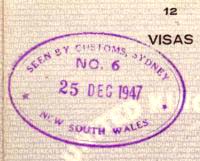
In Sydney we stayed at a hotel in Rose Bay for a few days
before heading for South Australia. While in Sydney the
film, 'The Overlanders', had its premiere. It was funny
to see the women wearing furs to the premiere, in the Christmas
heat. Also there were cars with gas bags on their roofs
for gas-producers and of course there were the trams. The
only person we had later contact with was Pat's guardian/mother
who found a husband.
* Date confirmed by the author's passport
|
Stephen Rose's Passport
The Captain's Log Book
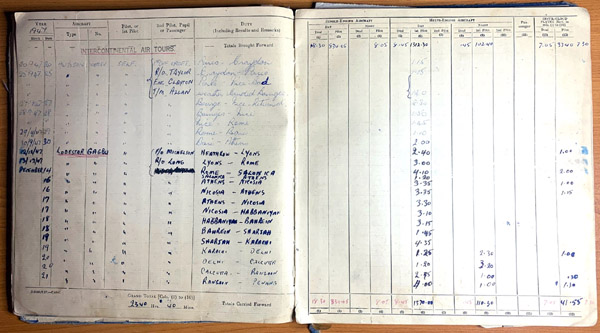
The
Pilot's Log Book belonging to the Captain of Lodestar G-AGBU,
Warren Penny.
(Click on the image for a larger view of both pages)
And how did young
Stephen's new life turn out?
After arriving
in Sydney on Christmas Day 1947, my mother and I stayed
at a hotel in Rose Bay for a couple of weeks. Then we headed
off by train to Adelaide where she got a job as cook on
a Stud Merino sheep station near Booboorwie in the Far North
of SA. What a change for urban folk. Booboorwie was about
two miles away and only a small village! That year schools
were closed for some months due to the polio epidemic.
Our next stop was Morthett Vale near Adelaide when the area
was still rural. We stayed with friends from the next-door
sheep station at Booboorwie. After a few months there we
went to Karoonda, a railway junction in the mallee of SA,
where my mother was manageress of the Railway Refreshment
Rooms. Then, together with a friend from Yugoslavia, who
had to work two years on the railway to repay his passage,
took up poultry (egg) farming at Apamurra, a hamlet of about
six houses on the railway between Palmer and Mannum (on
the River Murrray). Here I finished primary school and intermediate
certificate at Birdwood High before having to leave school
with deteriorating eyesight.
The eyesight was stabilised but I had to work out of doors.
I tried dairy farming, working as a chainman and eventually
as a cabinetmaker. At 17, I joined the Royal Australian
Survey Corps for six years; working mainly in PNG and NT
when not on training courses. On leaving the Army I worked
for the SA Lands Dept while waiting for a job with the NT
Lands. While working I did Matriculation by correspondence
course and later 11 surveying subjects the same way, to
become a Licensed Cadastal Surveyor.
Later I worked in PNG surveying disputed land before Independence.
I worked further in the NT until I had to remain within
a day's travel of the eye clinic. I took up computer programming
in 1976 and did it until my retirement in 1999. In 1998
I had moved from Darwin to the Glass House Mountains while
taking long-service leave.
|
The
full history of Lodestar G-AGBU
(This
link will take you to another website)
|
Issue
|
Date
|
Remarks
|
|
2
|
12APR21
|
Added
images of the Captain's log book thanks to Greg Weir. On the
basis of this log book, some stated uncertainties in Stephen
Rose's 2011 account have been corrected. On the other hand,
Stephen Rose's account has been used to correct an apparent
anomaly in Warren Penny's log book which shows that the aircraft
overnighted in Koepang on 23DEC but it is more likely that
the aircraft continued on to Darwin where Stephen Rose recalls
overnighting on 23DEC. Unfortunately his passport does not
record his arrival in Darwin! |
|
1
|
AUG11
|
Original
issue. |
|




